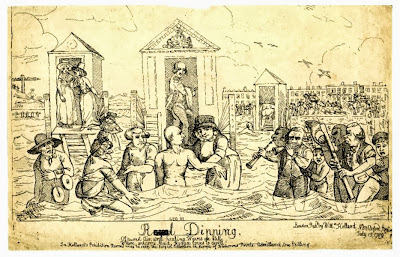 |
| George III from The History of the Reign of George III by Robert Bissett (1822) |
George III was a frequent visitor to my home town of Weymouth. He visited nearly every year between 1789 and 1805. In my presentation, George’s seaside adventure, I talk about the King’s first visit to Weymouth in 1789 and share two of the more unusual things that happened to him on that occasion.
Did it really happen like that?
Both anecdotes are recorded by author Fanny Burney in the Diaries and letters of Madame d'Arblay.1 Fanny was second keeper of the robes to Queen Charlotte at the time and accompanied the royal party to Weymouth. Apparently the mayor of Weymouth really did have a wooden leg. Unfortunately, though his excuse for not kneeling was perfectly reasonable, the rest of his party followed his lead, and none of them knelt before the King and Queen!
 |
| Fanny Burney from Diary and letters of Madame D'Arblay (1846) |
The whole country celebrated the King’s recovery from his incapacitating illness with zeal. Everywhere the King went, crowds of people turned up to see him, frequently launching into the national anthem and cheering His Majesty. Weymouth was no exception.
Fanny Burney wrote:
The king, and queen, and princesses, and their suite, walked out in the evening; an immense crowd attended them—sailors bargemen, mechanics, countrymen; and all united with so vociferous a volley of "God save the king", that the noise was stunning.
The preparations of festive loyalty were universal. Not a child could we meet that had not a bandeau round its head, cap, or hat, of "God save the king"; all the bargemen wore it in cockades and even the bathing-women had it in large coarse girdles round their waists. It is printed in golden letters upon most of the bathing-machines, and in various scrolls and devices it adorns every shop and almost every house in the two towns.2
The story of the band playing when George III went for his first dip was famously caricatured in John Nixon’s print.
 |
Royal dipping – print by John Nixon, published
by William Holland (1789) © British Museum |
The king bathes, and with great success; a machine follows the royal one into the sea, filled with fiddlers, who play "God save the king," as his majesty takes his plunge!2
If you enjoyed this video, you might like my other YouTube videos:
The three Charlottes – Queen Charlotte, Princess Royal and Princess Charlotte of Wales.
A litter of cupolas – Brighton Pavilion in 1823.
The three Charlottes – Queen Charlotte, Princess Royal and Princess Charlotte of Wales.
A litter of cupolas – Brighton Pavilion in 1823.
Rachel Knowles writes faith-based Regency romance and historical non-fiction. She has been sharing her research on this blog since 2011. Rachel lives in the beautiful Georgian seaside town of Weymouth, Dorset, on the south coast of England, with her husband, Andrew.
Find out more about Rachel's books and sign up for her newsletter here.If you have enjoyed this blog and want to encourage me and help me to keep making my research freely available, please buy me a virtual cup of coffee by clicking the button below.
Note
1. Madame d'Arblay is Fanny Burney's married name.
2. From the Diary and letters of Madame D'Arblay by Fanny Burney (1846).
1. Madame d'Arblay is Fanny Burney's married name.
2. From the Diary and letters of Madame D'Arblay by Fanny Burney (1846).
Sources used include:
Burney, Fanny, Diary and letters of Madame D'Arblay, edited by her niece, Charlotte Barrett (Henry Colburn, 1846, London)
Chedzoy, Alan, Seaside Sovereign - King George III at Weymouth (The Dovecote Press, 2003, Wimborne)
Burney, Fanny, Diary and letters of Madame D'Arblay, edited by her niece, Charlotte Barrett (Henry Colburn, 1846, London)
Chedzoy, Alan, Seaside Sovereign - King George III at Weymouth (The Dovecote Press, 2003, Wimborne)


No comments:
New comments are not allowed.